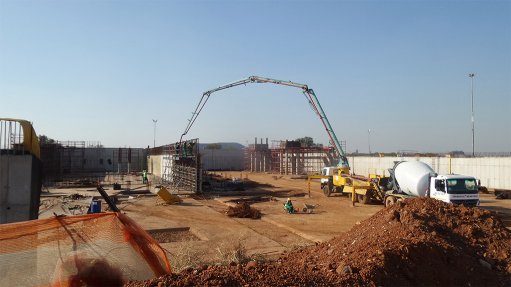
LION’S SHARE The civils contract for the Meyerton Waste Water Treatment Works project, which is expected to be completed by the end of this year is estimated at R88-million
The civil engineering works for the extension of the existing Meyerton Wastewater Treatment Works (WWTW) south of Johannesburg, in Gauteng, is progressing well and expected to be completed by the end of this year, while completion of the mechanical contract for the project is slated for April 2017, says engineering consultancy Gibb.
Black-owned Gibb was appointed by the Midvaal local municipality to design and implement the extension of the WWTW. The appointment, effective since June 2011, was made following the completion of a feasibility study by Rand Water, which indicated that an expansion of the works was necessary in view of future increased sewage flows.
The building and all site aesthetics, as well as the extension phase, are divided into three contracts: the civils contract for the civil engineering works, which is currently under way; the mechanical contract; and the electrical contract. The tender for the mechanical contract was awarded to water treatment specialist SAME Water in March, explains design engineer Rorisang Lekonyana.
“Gibb has further submitted the tender documentation for the appointment of an electrical contractor to the project,” Lekonyana says, noting that the firm expects the contract to be awarded in the near future.
The civils contract for the project is estimated at R88-million, the mechanical contract at R18-million and the electrical contract at R27-million, amounting to a total project value of about R133-million. The project is on schedule and within budget, Lekonyana says.
The extension phase includes construction of a new head of works, a raw-water pumpstation, a new biological nutrient removal (BNR) unit (or bioreactor), an additional secondary settling tank (SST), sludge drying beds and a new administration building for the treatment works.
Gibb aims to ensure that the water and wastewater treated at the WWTW align with the South African Green Drop certification for excellence in wastewater treatment plant operations, Lekonyana emphasises.
“Wastewater treatment works are critical in protecting South Africa’s water resources,” he says, adding that construction of these projects highlights municipal and government intent to improve the quality of water released into rivers.
Project Requirements
The Meyerton WWTW project encompasses a review of the bulk wastewater infrastructure and management processes at the site of the existing works.
The existing works, commissioned in 1977, has a design capacity of 5 Mℓ/d. It was conceived as an extended aeration facility without primary sludge removal, consisting of a single five-stage BNR Bardenpho/Phoredox reactor, followed by a single clarifier, which was later converted into a three-stage Phoredox configuration.
The works were formerly fed through a side-stream balancing pond from a pumpstation at Rothdene and Rus Ter Vaal. To increase treatment capacity and prevent overloading, this pond was converted into an aerated balancing tank in 2007, while the sludge handling facilities were upgraded at the same time. This increased the design capacity of the works to 10 Mℓ/d.
“The scope of work and existing infrastructure necessitated that Gibb implement the project in three phases, incorporating the ‘debottlenecking’, refurbishment and extension phases,” Lekonyana explains.
The ‘debottlenecking’ phase involves introducing a new SST to handle the incoming sewage flow and allows for the refurbishment of the old SST. The new SST has been introduced downstream of the existing BNR and in parallel with the old SST.
The new SST will also form part of the upgrading of the works to increase the capacity from 10 Mℓ/d to 25 Mℓ/d. Also included in this phase is the construction of a new chlorination building and the installation of a new disinfection system.
The refurbishment phase included refurbishing the old SST by repairing the tank structure and replacing all the mechanical equipment, which had been in operation for almost 40 years.
Lekonyana highlights that an important feature of the entire project is that, while the existing works will form part of the extended works, the old and new works will generally function independently of each other.
However, there will be a facility to discharge mixed liquor from the old biological reactor to the new SSTs, when the old SST requires maintenance, he concludes.